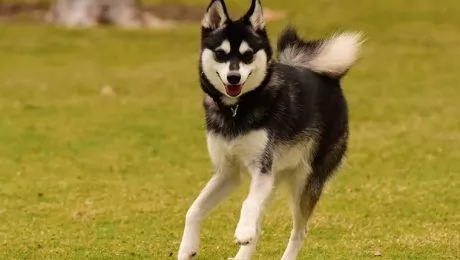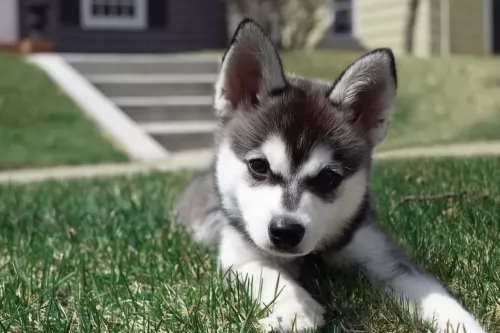 Petzlover
PetzloverAlaskan Klee Kai is originated from United States but Toy Schnauzer is originated from Germany. Alaskan Klee Kai may grow 9 cm / 4 inches higher than Toy Schnauzer. Alaskan Klee Kai may weigh 6 kg / 14 pounds more than Toy Schnauzer. Both Alaskan Klee Kai and Toy Schnauzer has almost same life span. Both Alaskan Klee Kai and Toy Schnauzer has same litter size. Alaskan Klee Kai requires Low Maintenance. But Toy Schnauzer requires Moderate Maintenance
 Alaskan Klee Kai breed is created in Alaska by Linda S Spurlin with help of her family. When she saw a smaller type of Siberian Husky, she immediately wanted to create a smaller type of Husky that will be a great companion dog. She did not create this breed with dogs that suffer from dwarfism as if it’s the case with most other breeders. She breeds Alaskan Husky with smaller dog breeds that looked a like a husky. Breeds like Alaskan Eskimo Dog or Schipperke. They are still not recognized by some Kennel clubs, but their popularity is constantly on the rise.
Alaskan Klee Kai breed is created in Alaska by Linda S Spurlin with help of her family. When she saw a smaller type of Siberian Husky, she immediately wanted to create a smaller type of Husky that will be a great companion dog. She did not create this breed with dogs that suffer from dwarfism as if it’s the case with most other breeders. She breeds Alaskan Husky with smaller dog breeds that looked a like a husky. Breeds like Alaskan Eskimo Dog or Schipperke. They are still not recognized by some Kennel clubs, but their popularity is constantly on the rise.
The Miniature Schnauzer was actually a distinct breed as early as 1899. It is believed that the dog came from breeding the smallest Standard Schnauzers with Affenpinschers, Black Poodles, and the gray Spitz.
Miniature Schnauzers were registered as a separate breed in 1926. The Toy Schnauzer is registered as a Miniature Schnauzer but is actually a little bit smaller.
The Miniature Schnauzer was developed as a farm dog with the purpose of killing rats.
 Weight of the Alaskan Klee Klei variates from dog to dog, but average male size is between 33-44cm. While females size is 28-40cm. The weight of the average male, an adult dog is 13 to 15kg. As you may see Klee Klei can be very small dogs, and that depends on every dog.
Weight of the Alaskan Klee Klei variates from dog to dog, but average male size is between 33-44cm. While females size is 28-40cm. The weight of the average male, an adult dog is 13 to 15kg. As you may see Klee Klei can be very small dogs, and that depends on every dog.
A lifespan of Klee Klei is 12-16 years.
Litter Size of the breed again depends on every dog but normal size for this breed is between 4-8 puppies.
Other Name for Alaskan Klee Klei is just a Klee Klei.
The Toy Schnauzer is a small dog standing at between 33–35cm tall and weighing about 4 to 9 kg.
He has medium length hair which is hard and wiry and which requires minimal grooming. These low-shedding dogs make the ideal family pets for those people who have allergies.
Colors of the coat are essentially black and silver, chocolate or a salt and pepper look. You'll find they have a beard and bushy eyebrows, giving him an almost human-like expression.
These dogs were brought about to be all-around farm dogs and ratters and they are tough, muscular, and fearless without being aggressive.
 Klee Klei is very intelligent breed with a lot of energy. They love spending time with the family, especially in the outdoor activities. Klee Klei is very friendly towards children and new people, but they will also be excellent watchdogs too. Due to their intelligence, they are very easy to train. You should practice a positive way of awarding for them. They love pleasing and they love food, so it is a match made in heaven for training the Klee Klei. They will enjoy playing with other animals because they love to run and spend time with them, but you must socialize them from the early age. It is very important to socialize them with other animals and you will not have anything to worry about. They have a high prey drive so you will have to keep them on the leash while walking because if they notice something they will run towards it immediately. So for your, and your pet's safety, it is the best to keep the leash on. They do not bark a lot, but they will express when they are not pleasured because they can be very sensitive
Klee Klei is very intelligent breed with a lot of energy. They love spending time with the family, especially in the outdoor activities. Klee Klei is very friendly towards children and new people, but they will also be excellent watchdogs too. Due to their intelligence, they are very easy to train. You should practice a positive way of awarding for them. They love pleasing and they love food, so it is a match made in heaven for training the Klee Klei. They will enjoy playing with other animals because they love to run and spend time with them, but you must socialize them from the early age. It is very important to socialize them with other animals and you will not have anything to worry about. They have a high prey drive so you will have to keep them on the leash while walking because if they notice something they will run towards it immediately. So for your, and your pet's safety, it is the best to keep the leash on. They do not bark a lot, but they will express when they are not pleasured because they can be very sensitive
The Toy Schnauzer is spunky, strong-willed and confident. They all have different personalities and while some people report they are aloof, stubborn and uppity, others say they are playful, friendly and amicable.
A lot depends on the owners as dogs often develop the temperaments of the owners.
With this range in temperament, you can’t say with certainty how your Toy Schnauzer will turn out. Most of them just want to be involved with their human families and they make great family pets.
 As most of the small breed dogs that are mixed with various breeds, this is one of the healthiest breeds. They do not have a lot of health issues, and usually, they tend to live a lot. Of course, you must be careful where are you buying your dog, and it is very important to choose the right owners that are taking care of the dogs and puppies. Some of the issues that this breed might have are luxation patella, thyroid disease, heart conditions, liver shunts, factor VII deficiency, and cataracts.
As most of the small breed dogs that are mixed with various breeds, this is one of the healthiest breeds. They do not have a lot of health issues, and usually, they tend to live a lot. Of course, you must be careful where are you buying your dog, and it is very important to choose the right owners that are taking care of the dogs and puppies. Some of the issues that this breed might have are luxation patella, thyroid disease, heart conditions, liver shunts, factor VII deficiency, and cataracts.
Your Toy Schnauzer has a life expectancy of 12 – 15 years if you care for them properly. They can, however, suffer from some health problems that so many other dogs might also have to contend with.
You’ll notice your pet's eyes taking on a filmy look. Most times these cataracts emerge in older dogs and they can be surgically removed.
Entropion and Progressive Retinal Atrophy (PRA) are other eye diseases that may affect your dog. Most dogs are able to adapt well to their limited vision and can even adapt to lost vision.
A bladder infection can be terribly uncomfortable for your pet and occurs when bacteria gets into the bladder. Females are more likely to get a bladder infection, but male dogs can pick up the infection too. Having a bladder infection increases the pet’s urge to urinate even when there is no urine to come out.
The little bit of urine that does come out may be cloudy or even have some blood in it. It is imperative to get your pet urgent veterinary attention. When you see your pet trying to urinate all the time with nothing happening, then this is the sign to get your dog to the vet for a course of antibiotics.
This is when food and liquid are retained in the dog's esophagus so that you find him regurgitating his food. This can lead to pneumonia.
 Since they are highly energetic dogs they will need a lot of fuel for playing and spending time outside. Feeding of your dog depends on daily activity, but overall you should consult with dog nutritionist for a better understanding of your dog needs.
Since they are highly energetic dogs they will need a lot of fuel for playing and spending time outside. Feeding of your dog depends on daily activity, but overall you should consult with dog nutritionist for a better understanding of your dog needs.
Puppies need more food divided into 3-5 meals per day. They would eat everything you have for them. 3-5 high-quality dry food would be enough with additional vitamins and minerals.
Normally, Klee Klei groom themselves, so you won’t have to do it too often. Again, you will have to take care of your dog with occasional baths and brushing. You will know when is the time to take care of your lovely Klee Klei, but they will do most of the work.
Most people have their Toy Schnauzers professionally groomed on a regular basis. He is a double-coated dog with a wiry coat. Some people, looking to maintain the wiry texture do hand-stripping, certainly if the dog is used for show purposes.
No dog deserves to have dry kibble served up to him day after day. However, there are some excellent commercial dog foods on the market and you can choose the best one.
These foods provide a lot of convenience for the dog owner. Dogs also need to have their share of home-made food. It doesn’t have to be all complicated as dogs like simplicity.
Wholesome foods such as boiled chicken, brown rice and some nutritious vegetables such as sweet potatoes, spinach and carrots can do him the world of good. Schnauzers are also prone to pancreatis so you want to avoid giving him food that is high in fat.
Toy Schnauzers love an active lifestyle. They don't like sitting around inactive for too long.
Your Toy Schnauzer can adapt to life in the country or the city but he will certainly need to be well exercised. Walking your dog each day will be essential as will ball games and just generally giving your pet some of your attention,